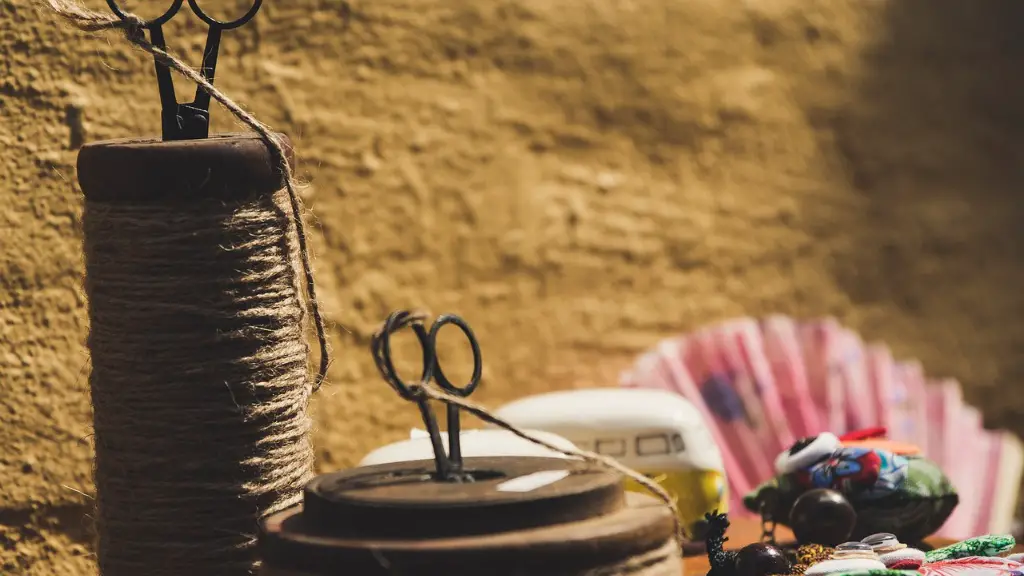Material Selection
When it comes to making a sewing machine bag, an important question to start with is what material should be used. This project can be easily completed with a range of fabrics such as cotton, vinyl, or canvas. Cotton is a lightweight, relatively inexpensive fabric that has some stability and is also fairly easy to clean. Vinyl is another option, featuring a sleek and glossy look. It is a sturdier fabric and is resistant to water or other liquids. Lastly, canvas fabric tends to be the most heavy duty and is insulating, making it useful when working with crochet hooks or other delicate items.
Tools and Supplies
In addition to the material you select, there are several other tools and supplies you will need in order to make a sewing machine bag. These include thread, a pair of scissors, a ruler or measuring tape, a sewing machine, and a few other small items. Any sewing machine should be suitable for this project, although some machines might require different settings or attachments.
Measurements and Markings
With the right tools and supplies in hand, the next step is to measure and mark the fabric. Depending on the type of sewing machine bag you want to make, the measurements will vary. The simplest type is a single rectangular piece in which the height is twice the depth and the width is larger than the depth. This bag can be easily adapted to fit any size sewing machine.
Once the measurements have been taken and marked, the fabric should be cut according to the measurements. It is important to use sharp scissors for this step as fabric can fray or unravel if cut with dull scissors.
Sewing
Once the fabric has been cut, the sewing portion of the project can begin. A standard sewing machine should be used for this step as more complex methods such as serging are not necessary. Begin by using a basting stitch to join the two sides of the fabric together. Then use a straight stitch to join the bottom edges together and make a seam.
Next, work on the corners of the bag. Live stitches should be left on each corner so the corners can be tacked down. Once these corners are in place, it’s time to turn the bag right side out and press it.
The Drawstring
The next step is to create the drawstring. For this, an elastic or drawstring cord will be needed. Measure twice the length of the bag’s circumference. Take into consideration the gap where the drawstring will be threaded through and double that measurement. Cut the cord and use a buttonhole foot to create buttonholes on each side of the bag above the seam.
Once both buttonholes have been created, thread the drawstring through the bag and tie the ends together. The ends of the drawstring will be tucked inside the bag, so be sure to secure them with a few stitches.
Stabilization
Once the drawstring is in place, you can work on stabilizing the sewing machine bag. This will help keep the shape of the bag and prevent it from stretching out or slouching down. To do this, measure and cut two pieces of lightweight interfacing. These pieces should fit into the bottom and sides of the bag and be secured in place with a few stitches.
Handles
The last step of making a sewing machine bag is to attach the handles. Measure twice the length of the bag and cut two pieces of fabric or ribbon to match. Fold them in half and press them into place along the top edges of the bag. Secure the handles in place with a few stitches and the bag is complete and ready for use!
Padding and Lining
In order to add more protection to the sewing machine bag, it’s a great idea to add padding and a lining. This will help prevent scratching and cushion any contents placed inside the bag. To add padding, a few pieces of quilt batting or foam can be cut and sewn together to fit the dimensions of the bag. This can then be placed inside the bag and secured with a few stitches.
To add a lining, select a coordinating piece of fabric and cut two panels to the same dimensions as the bag. Place them right sides together and sew along the bottom and sides of the fabric pieces. Leave an opening at the side of the bag in order to turn the fabric right side out. Then, tuck the lining into the bag and hand stitch the opening closed.
Customization
In addition to learning how to make a sewing machine bag, there are also some fun ways to customize it. Embellishments such as fabric paint, patches, or embroidery thread can help make the bag unique and add interesting visual elements. This is a great way to make any bag fit your personal style and show off your creative spirit.
Finishing Touches
The perfect finishing touch for any sewing machine bag is a pair of shoulder straps. This will help keep the bag firmly secured to the shoulder and make it easier to carry around. To make the straps, cut two pieces of webbing in the desired length and sew them into place along the side seams of the bag.
Care and Maintenance
Once the sewing machine bag is complete, it’s important to take care of it properly. Since these bags are mainly composed of fabric, it’s important to wash them with cold water in order to protect their shape and overall construction. It is also important to periodically check the drawstring and elastic cords to make sure they are secure and not worn out.
In addition to regular washing, the bag can also be treated with a fabric protector to ensure that it is waterproof. This should be done before the bag is used for the first time, as well as after each washing. Regular applications of fabric protector will help keep the bag looking new for years to come.
Storage and Transportation
One of the main benefits of a sewing machine bag is its easy storage and transportation. When not in use, the bag can simply be folded or rolled up and stored away. This will help to keep it safe and secure when not in use.
When it comes time to transport the bag, it is important to use a sturdy bag to prevent any damage. It is also wise to fill the bag with some type of padding or other cushioning to help keep the sewing machine in place. This will help to protect it from any bumps or shocks that could occur while on the go.
Conclusion
Creating a sewing machine bag is a great way to use up fabric scraps and show off your creative flair. With the right tools and supplies, this project can be easily completed in just a few hours. In addition to learning how to make a sewing machine bag, taking the proper steps to care for and transport it is also important. With the proper care and maintenance, this type of bag will offer years of use and enjoyment.



